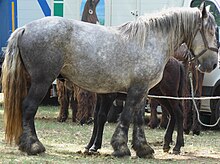Poitevin horse
On 1 January 1599, Henri IV of France appointed Humphrey Bradley, an English land drainage engineer from Brabant, maître des digues du royaume, or "master of dykes of the Kingdom", which essentially gave him a monopoly of all dyking and land reclamation work throughout the country.
[7][8]: 100 Bradley also enjoyed the support of Maximilien de Béthune, Duke of Sully, chief minister to the king.
They brought a good number of workers from the Low Countries; by about 1610 the area between Muron and Tonnay-Charente had come to be known as the Marais de la Petite-Flandre, the "marsh of little Flanders".
[9]: 81 It is believed that a number of working horses were also brought from the Low Countries, possibly of Brabant, Flemish or Friesian type.
Despite financial incentives,[3] private breeders protested because they felt that the resulting crossbred horses created poor quality mules upon further breeding.
The changes also affected the characteristics of the breed that had been developed for work in its marshy homeland,[14]: 14–16 including large hooves and a calm manner.
At the beginning of the nineteenth century, the government prohibited breeding mules from mares taller than 120 cm (11.3 h), and threatened to castrate all donkeys in the region.
[14]: 2 In the Deux-Sèvres region, especially in the district of Melle, near Luçon and Saint-Maixent, mule breeding began to be concentrated in ateliers (workshops), which were relatively expensive for breeders.
[16]: 28 [18] Poitevin colts and fillies were sold at fairs in Marans, Nuaillé, Surgères, Rochefort, Pont-l'Abbé and Saujon.
[3] The Breton influence tended to make the head more square and the ears shorter;[17]: 561 [18] the Poitevin lost weight without gaining anything else, the legs became too long and too thin, and gray became more common as a coat color.
However, a distinction persisted between the real Poitevin and mixed-blood horses, and farmers who preferred the former preserved the type, which formed the base for the creation of the breed studbook.
[22] The first edition was released December 31, 1885,[16]: 44 setting the physical criteria for breeding, and ending the practice of promoting crossbred horses as purebreds.
[14]: 14–16 In 1902, a breeding syndicate to promote Poitou mules was created, but disappeared after a lack of advertising by stock breeders.
The closing of the studbook brought about additional purebred breeding and selection based on conformation, color and working ability.
[14]: 14–16 In 1923, an association of Poitevin breeders was founded,[15]: 125 but declining livestock production pushed the group to reorganize in 1937 in order to gain more support from the government, through bonuses and subsidies.
[15]: 125 By 1922, Poitevin foals became difficult to sell,[14]: 18 and the population dropped dramatically as there was no economic incentive for breeding.
[3][11]: 179 Sources are unclear on the number of living Poitevins in the early 1990s, but by 1996 one author says there were 64 newly registered foals and 28 approved breeding stallions,[23]: 390 while another gives a total population of 293 horses in 1997.
[12]: 30 At the same time, crossbreeding with Friesian and Belgian horses was suggested to increase genetic diversity using morphologically and historically similar breeds.
[15]: 125 The French government distributes bonuses to the owners of the best stallions, a program more important to the Poitevin than to other draft breeds because of the significant possibility of extinction.
[14]: 23 The Poitevin had a slight increase in numbers at the beginning of the twenty-first century,[15]: 125 and could count approximately 100 farms perpetuating the breed.
[15]: 125 In 2006 it was still considered the most endangered French horse breed, with fewer than 100 births per year[12]: 30 and a slightly decreasing population.
It suggested making these breeds a conservation priority in order to maintain maximum genetic diversity among the French horse population.
[13] The majority of breeding farms are located in the Poitou area, including Vendée (especially around Fontenay-le-Comte and Luçon), Deux-Sèvres (especially near Melle), Vienna and Civray, and some in Charente, near Ruffec.
[29] The Poitevin has large hooves, an advantage in wet environments, as an adaptation to the alternately hard and waterlogged marshes upon which it developed.
[3] The wide range of coat colors may be partly the result of the many breeds that influenced it: black and seal brown (French: noir pangaré) may derive from Flemish and Friesian horses, bay roan was probably inherited from the Brabant breed, while chestnut and chestnut roan may result from the Breton influence; gray and bay are also common.




